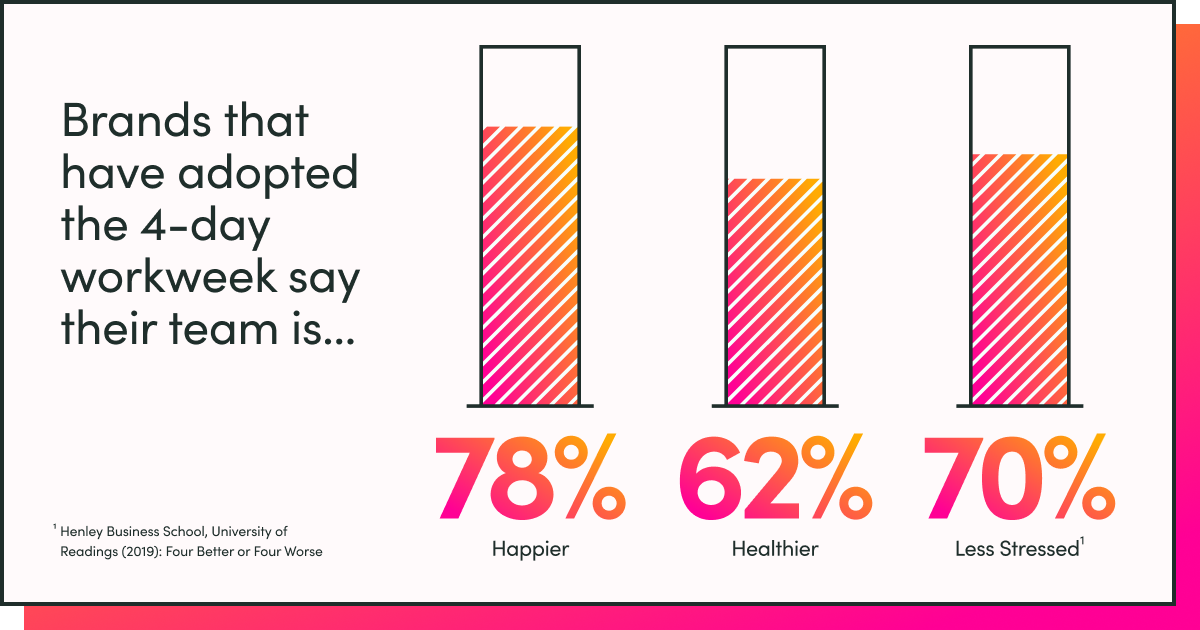Why Should I Track my Time (other than to Make my Boss Happy)?
Tracking your time every day – and making it part of your daily workflow – can be beneficial for personal and company productivity.

Amid all the radical changes that happened in the work zone during the last few years, the rise of the 4-day workweek has definitely been the most talked about.
Are people working 4 days actually more productive? Is it too good to be true? Are we really seeing the end of the 9 to 5, Monday to Friday model?
Alrighty then, let's dive into what all the fuss is about with the 4-day workweek. We'll take a look at how it works, which countries have given it a shot, and what the results have been.
Stay until the end of the article for the final verdict!
A 4-day workweek simply means reducing the days spent at work while maintaining the same retribution. Typically, workers get Fridays off.
The part about retribution is particularly important: the purpose of the trials was to demonstrate that workers can be as efficient, by working smarter, not longer.
The idea is that focusing on efficiency instead of hours worked can produce the same results as in a traditional work setting.
The idea behind the 4-day week is to optimize time and resources. By concentrating on the tasks in a shorter period of time (for the same retribution), workers can focus on getting things done more efficiently, reducing wasted time and downtime.
Also, the fact that workers will have to enjoy a longer, three-day weekend can help reduce stress and burnout, with positive effects expanding also to the organization as a whole.
Given all the benefits that a 4-day workweek can bring (in theory), it's understandable that many countries have started exploring the option. So, how did it go?
So far the world's biggest trial for the new 4-workweek has been done in the UK.
Companies in the UK were involved in a six-month program that launched in 2022.
According to Euronews, 61 UK companies and more than 3,300 employees signed up for the trial, run by researchers at Cambridge and Oxford Universities and Boston College, as well as the non-profit advocacy groups 4 Day Week Global, the 4 Day Week UK Campaign and the UK think tank Autonomy.
According to the final report published by 4 Day Week Global, the results of the trial were overwhelmingly positive.
Almost 92% of the companies involved in the trial decided to keep the 4-day workweek permanent after the trial. The change has resulted in a happier, more loyal workforce with no loss of productivity.
Iceland was among the trailblazers in testing the 4-day workweek, starting its trials in the country between 2015 and 2019.
More than 2,500 took part in the test. Weekly working hours were cut from the traditional 40 to 35/36, with no difference in pay.
The experiment was very successful: workers saw a drastic reduction in stress, burnout dropped, and their work-life balance improved.
According to Euronews, it led to Icelandic trade unions negotiating a reduction of worked hours nationally.
Unilever's branch in New Zealand ran a test trial of the 4-day workweek in its companies, from December 1st, 2020 to June 30th, 2022.
The smaller-scale trial involved 80 employees, who worked 80% for a week while retaining 100% of their salaries.
The results were positive: absenteeism dropped 34%. Individual well-being also improved, with stress dropping 33%. Meanwhile, feelings of strength at work increased by 15% and work-life conflict fell by 67%. (Source)
Because of the promising results, Unilever decided to extend the experiment to its Australian branches as well.
Italy has started its trials with the 4-day workweek, but these trials so far are dependent on the will of a few big companies, rather than part of a systemic experiment in the country.
The few companies who tried it (Awing Italian and Carter & Benson, among others) have seen an improvement in employee well-being as well as positive effects on branding and company image.
Bigger companies like Intesa San Paolo have started offering the 4-day workweek as part of the company welfare.
Microsoft Japan run a small test in August 2019, giving its entire 2,300-person workforce five Fridays off in a row without decreasing pay.
According to The Guardian, productivity jumped by 40%, with employees having shorter, more efficient meetings, and generally being more happy and relaxed at work.
Panasonic Japan implemented its own trial in 2022.
In 2021, the Japanese government's annual economic policy guidelines included a recommendation that companies let employees opt for a four-day workweek and, by extension, a 3-day weekend.
Currently, trial runs of the 4-day workweek are ongoing in countries like Spain, Portugal, the US, Belgium, and Germany.
As you can see from the experiments that I described above, so far the 4-day workweek has proven to be an overwhelming success.
For many, these results weren't exactly a surprise. Back in 2018, Harvard Business Review published a study showing how shorter workdays can have positive effects on companies and employees alike.
In general, the benefits can be summed in:
- drastically decreased burnout (which translates to less health-related costs for companies and workers);
- increase free time for workers, who get to spend time (and money!) on leisure activities;
- positive effects on gender equality;
- increased company loyalty, which also translated to less turnover (with its related costs)

As the trials are still ongoing and rather scattered around the world, it's important to note that not all experiments have worked for every business.
Some UK firms dropped from the nationwide trial altogether. Meanwhile, in countries like Sweden, the 4-day workweek was met with mixed results, and all trial runs eventually were put on hold.
Some industries may struggle more than others, due to the nature of the work itself: for example, for customer-facing businesses creating enough slack in the schedule for a four-day week means extra hiring costs, that companies simply cannot afford.
Another risk could be that employees while rushing to finish the work within four days, may actually end up working longer, uninterrupted hours.
Every company that wants to test a 4-day workweek should consider its pros and cons carefully. As we know by now, not every industry may be cut for this model. And it's a pretty big change that will have effects on company planning and performance.
.webp)
Project and Time Tracking by Timeneye
The modern workplace is changing fast. Employees are more aware of the risks of burnout and value work-life balance a lot.
The 4-day work week, if implemented correctly, can improve a company's productivity and the workers' well-being.
What do you think? Is it time to kiss the 5 day work week goodbye? Let us know in the comments!
Whether you work a 4 or 5-day work week, we can help you keep productive and crush your goals. Read all our articles and resources on productivity and time management!
Tracking your time every day – and making it part of your daily workflow – can be beneficial for personal and company productivity.
Hybrid teams let companies both work in the office, and in locations of their choosing the rest of the time. How do they keep productive? Find out!
Learn how to efficiently test Timeneye with your team, from setting up the workspace to importing data and creating project templates. Maximize your...